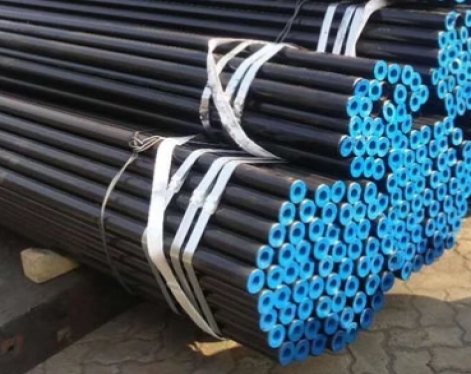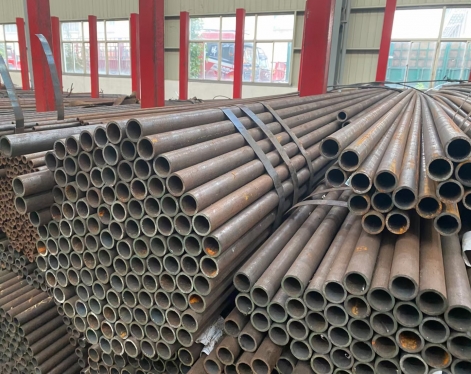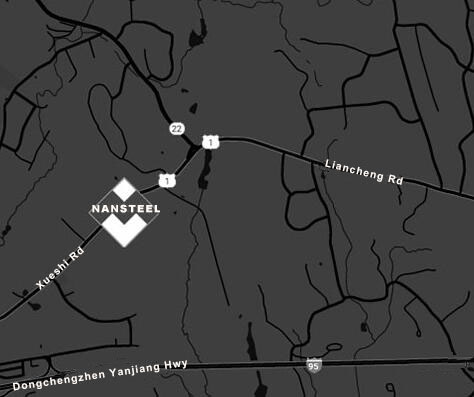Surface treatment technology for boiler tubes is a key process to ensure good corrosion resistance, wear resistance, high-temperature oxidation resistance, and extended service life during use. Boiler tubes operate in high-temperature, high-pressure, and corrosive environments, so the selection and application of surface treatment technology is crucial to their performance. The following are several common boiler tube surface treatment technologies:
1. Hot-dip galvanizing
Hot-dip galvanizing involves immersing boiler tubes in molten zinc, forming a zinc-iron alloy coating on the surface. This technique is primarily used to improve the corrosion resistance of boiler tubes, especially in humid or corrosive environments. The zinc coating not only acts as a physical barrier, protecting the base metal from contact with the corrosive medium, but also further protects the base metal through sacrificial anodic protection. The advantages of hot-dip galvanizing are its low cost, mature process, and suitability for high-volume production.
2. Electroplating
Electroplating is a process that deposits a layer of metal or alloy on the surface of boiler tubes through an electrolytic process. Common plating materials include nickel, chromium, and zinc. The electroplated layer can improve the corrosion resistance, wear resistance, and aesthetics of boiler tubes. For example, chrome plating offers excellent corrosion and wear resistance and is commonly used on boiler tubes used in high-temperature and high-pressure environments. While electroplating offers advantages such as uniform coating and controllable thickness, it also comes at the cost of higher costs and some environmental pollution.
3. Electroless Plating
Electroless plating is a method of depositing a metal layer on the surface of boiler tubes through a chemical reaction without the need for an external power source. Common materials for electroless plating include nickel, copper, and cobalt. The advantages of electroless plating are uniform thickness, a lack of pores, and the ability to coat complex workpieces. For example, electroless nickel coatings offer excellent corrosion and wear resistance, making them suitable for high-temperature and high-pressure environments. However, the disadvantages of electroless plating are high cost and a complex process.
4. Sandblasting
Sandblasting is a process that uses high-speed sand particles to impact the surface of boiler tubes, removing scale, rust, and other contaminants while also increasing surface roughness. Sandblasting improves the cleanliness and adhesion of the boiler tube surface, providing an excellent foundation for subsequent coating or plating. While sandblasting offers advantages such as ease of operation and low cost, it requires controlled sand particle size and pressure to avoid damage to the base metal.
5. Phosphating
Phosphating involves immersing boiler tubes in a phosphate solution to form a water-insoluble phosphate film on their surface. This film improves the corrosion and wear resistance of the boiler tubes while also providing good adhesion for subsequent coatings. While phosphating offers advantages such as low cost and a simple process, the film is relatively thin, resulting in limited corrosion resistance.

6. Oxidation Treatment
Oxidation treatment forms an oxide film on the surface of boiler tubes through chemical or electrochemical methods. Common oxidation treatment methods include anodic oxidation and chemical oxidation. The oxide film improves the corrosion resistance, wear resistance, and high-temperature oxidation resistance of boiler tubes. For example, anodized aluminum offers excellent corrosion and wear resistance and is suitable for high-temperature environments. While oxidation treatment offers the advantages of mature technology and low cost, the oxide film is relatively thin, resulting in limited corrosion resistance.
7. Coating
Coating is the process of applying one or more layers of organic or inorganic materials to the surface of boiler tubes. Common coating materials include epoxy resin, polyurethane, and ceramic. Coatings provide excellent corrosion resistance, wear resistance, and resistance to high-temperature oxidation. For example, ceramic coatings offer excellent high-temperature and corrosion resistance, making them suitable for high-temperature and high-pressure environments. While coating offers advantages such as excellent performance and wide applicability, it also comes at the cost of higher costs and a complex process.
8. Laser Surface Treatment
Laser surface treatment uses a high-energy laser beam to heat, melt, and cool the surface of boiler tubes to improve their surface properties. Laser surface treatment can enhance the hardness, wear resistance, and corrosion resistance of boiler tubes. For example, laser quenching can significantly improve the surface hardness and wear resistance of boiler tubes. Laser surface treatment offers advantages such as high precision and excellent results, but it also comes with high equipment costs and complex processes.
9. Ion Implantation
Ion implantation is the process of injecting high-energy ions into the surface of boiler tubes, altering their surface chemical composition and structure. Ion implantation can improve the hardness, wear resistance, and corrosion resistance of boiler tubes. For example, nitrogen ion implantation can significantly improve the surface hardness and wear resistance of boiler tubes. While ion implantation offers advantages such as high efficacy and a clean, pollution-free process, it also comes at the expense of high equipment costs and complex processes.
10. Carburizing and Nitriding
Carburizing and nitriding are processes that diffuse carbon or nitrogen atoms into the surface of boiler tubes, forming a high-hardness carbide or nitride layer. Carburizing and nitriding can improve the surface hardness, wear resistance, and corrosion resistance of boiler tubes. For example, the nitrided layer offers excellent wear and corrosion resistance, making it suitable for high-temperature and high-pressure environments. While carburizing and nitriding offer advantages such as high performance and wide applicability, they are complex processes and relatively high costs.
Conclusion
A variety of surface treatment technologies are available for boiler tubes, each with its own unique advantages and applicable scope. Choosing the appropriate surface treatment technology depends on the boiler tube's operating environment, performance requirements, and cost. Proper surface treatment can significantly improve the corrosion resistance, wear resistance, and high-temperature oxidation resistance of boiler tubes, extending their service life and ensuring the safe and stable operation of the boiler system.
Read more: Precautions for Using Boiler Tubes
1. Hot-dip galvanizing
Hot-dip galvanizing involves immersing boiler tubes in molten zinc, forming a zinc-iron alloy coating on the surface. This technique is primarily used to improve the corrosion resistance of boiler tubes, especially in humid or corrosive environments. The zinc coating not only acts as a physical barrier, protecting the base metal from contact with the corrosive medium, but also further protects the base metal through sacrificial anodic protection. The advantages of hot-dip galvanizing are its low cost, mature process, and suitability for high-volume production.
2. Electroplating
Electroplating is a process that deposits a layer of metal or alloy on the surface of boiler tubes through an electrolytic process. Common plating materials include nickel, chromium, and zinc. The electroplated layer can improve the corrosion resistance, wear resistance, and aesthetics of boiler tubes. For example, chrome plating offers excellent corrosion and wear resistance and is commonly used on boiler tubes used in high-temperature and high-pressure environments. While electroplating offers advantages such as uniform coating and controllable thickness, it also comes at the cost of higher costs and some environmental pollution.
3. Electroless Plating
Electroless plating is a method of depositing a metal layer on the surface of boiler tubes through a chemical reaction without the need for an external power source. Common materials for electroless plating include nickel, copper, and cobalt. The advantages of electroless plating are uniform thickness, a lack of pores, and the ability to coat complex workpieces. For example, electroless nickel coatings offer excellent corrosion and wear resistance, making them suitable for high-temperature and high-pressure environments. However, the disadvantages of electroless plating are high cost and a complex process.
4. Sandblasting
Sandblasting is a process that uses high-speed sand particles to impact the surface of boiler tubes, removing scale, rust, and other contaminants while also increasing surface roughness. Sandblasting improves the cleanliness and adhesion of the boiler tube surface, providing an excellent foundation for subsequent coating or plating. While sandblasting offers advantages such as ease of operation and low cost, it requires controlled sand particle size and pressure to avoid damage to the base metal.
5. Phosphating
Phosphating involves immersing boiler tubes in a phosphate solution to form a water-insoluble phosphate film on their surface. This film improves the corrosion and wear resistance of the boiler tubes while also providing good adhesion for subsequent coatings. While phosphating offers advantages such as low cost and a simple process, the film is relatively thin, resulting in limited corrosion resistance.

6. Oxidation Treatment
Oxidation treatment forms an oxide film on the surface of boiler tubes through chemical or electrochemical methods. Common oxidation treatment methods include anodic oxidation and chemical oxidation. The oxide film improves the corrosion resistance, wear resistance, and high-temperature oxidation resistance of boiler tubes. For example, anodized aluminum offers excellent corrosion and wear resistance and is suitable for high-temperature environments. While oxidation treatment offers the advantages of mature technology and low cost, the oxide film is relatively thin, resulting in limited corrosion resistance.
7. Coating
Coating is the process of applying one or more layers of organic or inorganic materials to the surface of boiler tubes. Common coating materials include epoxy resin, polyurethane, and ceramic. Coatings provide excellent corrosion resistance, wear resistance, and resistance to high-temperature oxidation. For example, ceramic coatings offer excellent high-temperature and corrosion resistance, making them suitable for high-temperature and high-pressure environments. While coating offers advantages such as excellent performance and wide applicability, it also comes at the cost of higher costs and a complex process.
8. Laser Surface Treatment
Laser surface treatment uses a high-energy laser beam to heat, melt, and cool the surface of boiler tubes to improve their surface properties. Laser surface treatment can enhance the hardness, wear resistance, and corrosion resistance of boiler tubes. For example, laser quenching can significantly improve the surface hardness and wear resistance of boiler tubes. Laser surface treatment offers advantages such as high precision and excellent results, but it also comes with high equipment costs and complex processes.
9. Ion Implantation
Ion implantation is the process of injecting high-energy ions into the surface of boiler tubes, altering their surface chemical composition and structure. Ion implantation can improve the hardness, wear resistance, and corrosion resistance of boiler tubes. For example, nitrogen ion implantation can significantly improve the surface hardness and wear resistance of boiler tubes. While ion implantation offers advantages such as high efficacy and a clean, pollution-free process, it also comes at the expense of high equipment costs and complex processes.
10. Carburizing and Nitriding
Carburizing and nitriding are processes that diffuse carbon or nitrogen atoms into the surface of boiler tubes, forming a high-hardness carbide or nitride layer. Carburizing and nitriding can improve the surface hardness, wear resistance, and corrosion resistance of boiler tubes. For example, the nitrided layer offers excellent wear and corrosion resistance, making it suitable for high-temperature and high-pressure environments. While carburizing and nitriding offer advantages such as high performance and wide applicability, they are complex processes and relatively high costs.
Conclusion
A variety of surface treatment technologies are available for boiler tubes, each with its own unique advantages and applicable scope. Choosing the appropriate surface treatment technology depends on the boiler tube's operating environment, performance requirements, and cost. Proper surface treatment can significantly improve the corrosion resistance, wear resistance, and high-temperature oxidation resistance of boiler tubes, extending their service life and ensuring the safe and stable operation of the boiler system.
Read more: Precautions for Using Boiler Tubes









